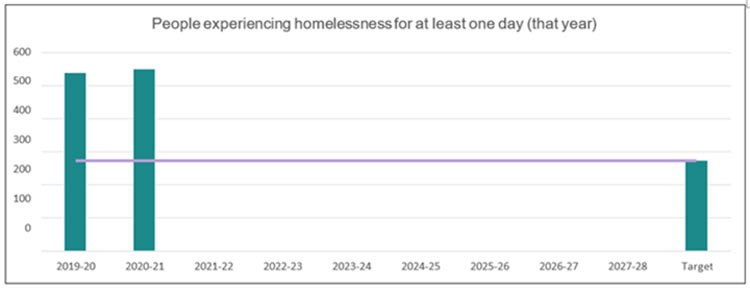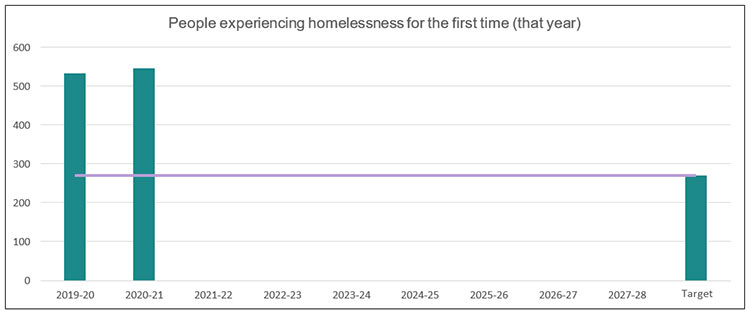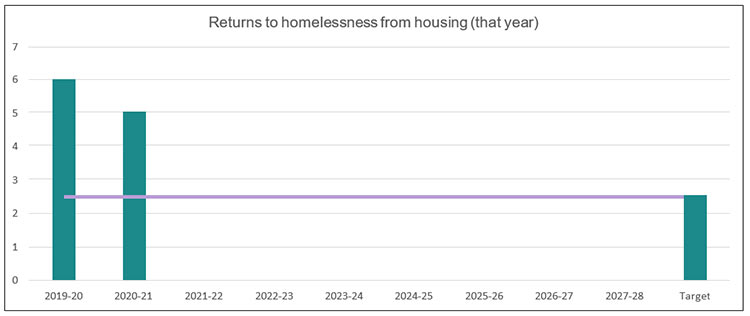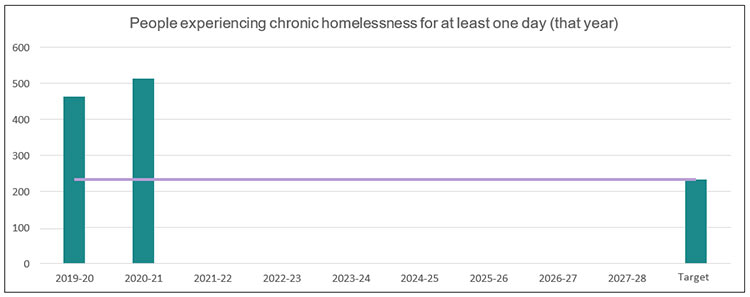2019-2021 Community Homelessness Report
The Community Homelessness Report (CHR) is an annual Reaching Home reporting deliverable that supports communities to prevent and reduce homelessness using a more coordinated, systems-based, and data-driven response.
The CHR was designed to support local discussions and decision-making, using all of the information about homelessness currently available at the community level. Communities are encouraged to use their CHR data to develop clear plans of action that help them to reach their homelessness reduction targets and to leverage the collective efforts of service providers working across the community, regardless of how they are funded.
This is a summary of the CHR for the 2019-2021 reporting cycle.
Coordinated Access and Homelessness Management Information System Self-Assessment
The table provides a summary of the work the community has done so far to implement Reaching Home’s minimum requirements for Coordinated Access and an HMIS.
How many of the Reaching Home minimum requirements has the community met:
Summary of work
This table scrolls horizontally on small screens. Use left and right arrow keys or touch swipe to view all columns.
Summary: counts of minimum requirements by status. Number of minimum requirements — Met: 18; Started: 0; Not yet started: 0.
| Requirement Category | Met | Started | Not yet started |
|---|---|---|---|
| Number of minimum requirements | 18 | 0 | 0 |
Summary comment
Are there particular efforts and/or issues that you would like to highlight for this reporting period related to your community’s work to achieve the Reaching Home minimum requirements? In particular, please describe your community’s efforts to set-up or improve the Coordinated Access governance structure, including processes to ensure that policies and protocols, as approved by the governance group(s), are being implemented across the system as intended to achieve desired results.
While COVID-19 hampered progress in local Coordinated Access development through the 2020-2021 fiscal year, Peel Region and its service partners still made many great strides toward the establishment of the local coordinated access system.
Early in the fiscal year, the facilitation approach and implementation plan were finalized with support from OrgCode Inc.
A governance model for the coordinated access system was established. An information session was hosted with local service providers to introduce coordinated access and solicit partnership for co-design. A co-design working group comprised of interested local service providers and persons with lived experience was established. Other jurisdictions service models were identified and reviewed, including meeting with community representatives, to establish best practices. The co-design working group developed a strong shared understanding of coordinated access and collective values.
The system framework was formalized, including eligibility, partner roles, and the high-level process. Collaborative case conferencing tables were established around the current By-Name List. A common assessment and intake were developed with and endorsed by the co-design working group. Some local resource inventory items were identified. The co-design working group identified local priorities and the development of a prioritization matrix.
Some development of policies, procedures, and job aids occurred during 2020-2021, as well as planning for further documentation needs. Other planning for further development to come in the 2021-2022 fiscal year includes:
- Coordinated access functionality in local HMIS
- Satisfaction of legal and privacy compliance requirements for data sharing and collaboration and
- Specific partner role fulfillment.
2019-2020 community-level data
What is the date range for available data from the List for this fiscal report?
- First date in reporting period: 2019-04-01
- Last date in reporting period: 2020-03-31
Complete the Population Groups table below using the date range indicated for this fiscal report.
Number of unique individuals (or households where not available) in each Priority Population Group who:
| Priority Population Groups | Were homeless (Measures Cumulative Homelessness) | Were new to homelessness (Measures Inflow) | Returned to homelessness from housing (one or more times) (Measures Inflow) | Returned to homelessness from transitional status (one or more times) (Measures Inflow) | Returned to homelessness from unknown status (one or more times) (Measures Inflow) | State changed from inactive to active (one or more times) (Measures Inflow) |
|---|---|---|---|---|---|---|
| Overall homeless | 537 | 531 | 3 | 0 | 2 | 1 |
| Chronically homeless | 463 | 459 | 1 | 0 | 2 | 1 |
| Indigenous peoples | 26 | 26 | 0 | 0 | 0 | 0 |
| Priority Population Groups | Were homeless (Measures Cumulative Homelessness) | Were new to homelessness (Measures Inflow) | Moved from homelessness to housing (one or more times) (Measures Outflow) | Status changed from homelessness to transitional (one or more times) (Measures Outflow | Status changed from homelessness to unknown (one or more times) (Measures Outflow) | State changed from active to inactive (one or more times) (Measures Outflow) |
|---|---|---|---|---|---|---|
| Overall homeless | – | – | 67 | 1 | 9 | 29 |
| Chronically homeless | – | – | 51 | 1 | 8 | 27 |
| Indigenous peoples | – | – | 1 | 0 | 1 | 3 |
Complete the Prior Living Situations table below for all individuals (or households where not available) that were homeless for the date range indicated for this fiscal report.
| Homelessness Status | Public Institutions | Transitional Housing | Permanent Housing | Unknown | Total |
|---|---|---|---|---|---|
| New to homelessness | 0 | 0 | 0 | 531 | 531 |
| Returned to homelessness | 0 | 0 | 0 | 6 | 6 |
| Total | 0 | 0 | 0 | 537 | 537 |
2019-2021 community-level data
What is the date range for available data from the list for this fiscal report?
- First date in reporting period: 2020-04-01
- Last date in reporting period: 2021-03-31
Complete the Population Groups table below using the date range indicated for this fiscal report.
Number of unique individuals (or households where not available) in each Priority Population Group who:
| Priority Population Groups | Were homeless (Measures Cumulative Homelessness) | Were new to homelessness (Measures Inflow) | Returned to homelessness from housing (one or more times) (Measures Inflow) | Returned to homelessness from transitional status (one or more times) (Measures Inflow) | Returned to homelessness from unknown status (one or more times) (Measures Inflow) | State changed from inactive to active (one or more times) (Measures Inflow) |
|---|---|---|---|---|---|---|
| Overall homeless | 549 | 544 | 3 | 0 | 0 | 2 |
| Chronically homeless | 513 | 510 | 3 | 0 | 0 | 2 |
| Indigenous peoples | 26 | 26 | 0 | 0 | 0 | 0 |
| Priority Population Groups | Were homeless (Measures Cumulative Homelessness) | Were new to homelessness (Measures Inflow) | Moved from homelessness to housing (one or more times) (Measures Outflow) | Status changed from homelessness to transitional (one or more times) (Measures Outflow | Status changed from homelessness to unknown (one or more times) (Measures Outflow) | State changed from active to inactive (one or more times) (Measures Outflow) |
|---|---|---|---|---|---|---|
| Overall homeless | – | – | 59 | 2 | 13 | 32 |
| Chronically homeless | – | – | 56 | 2 | 11 | 31 |
| Indigenous peoples | – | – | 3 | 0 | 1 | 4 |
Complete the Prior Living Situations table below for all individuals (or households where not available) that were homeless for the date range indicated for this fiscal report.
| Homelessness Status | Public Institutions | Transitional Housing | Permanent Housing | Unknown | Total |
|---|---|---|---|---|---|
| New to homelessness | 0 | 0 | 0 | 544 | 544 |
| Returned to homelessness | 0 | 0 | 0 | 5 | 5 |
| Total | 0 | 0 | 0 | 549 | 549 |
Community-level results outcomes - core outcomes
Outcome # 1: Fewer people experience homelessness overall (homelessness is reduced overall)
People experiencing homelessness for at least one day (that year).
| 2019-20 | 2020-21 | 2021-22 | 2022-23 | 2023-24 | 2024-25 | 2025-26 | 2026-27 | 2027-28 | Target |
|---|---|---|---|---|---|---|---|---|---|
| 537 | 549 | – | – | – | – | – | – | – | 271.5 |
People experiencing homelessness for at least one day (that year) image graph.

Targeting a 50% reduction to be in line with current Federal direction and goals.
Outcome #2: Fewer people experience homelessness for the first time (new inflows into homelessness are reduced)
People experiencing homelessness for the first time (that year).
| 2019-20 | 2020-21 | 2021-22 | 2022-23 | 2023-24 | 2024-25 | 2025-26 | 2026-27 | 2027-28 | Target |
|---|---|---|---|---|---|---|---|---|---|
| 531 | 544 | – | – | – | – | – | – | – | 269 |
People experiencing homelessness for the first time (that year) image graph.

Targeting a 50% reduction to be in line with current Federal direction and goals.
Outcome #3: Fewer people return to homelessness from housing (returns to homelessness are reduced)
Returns to homelessness from housing (that year).
| 2019-20 | 2020-21 | 2021-22 | 2022-23 | 2023-24 | 2024-25 | 2025-26 | 2026-27 | 2027-28 | Target |
|---|---|---|---|---|---|---|---|---|---|
| 6 | 5 | – | – | – | – | – | – | – | 2.5 |
Returns to homelessness from housing (that year) image graph.

Targeting a 50% reduction to be in line with current Federal direction and goals.
Outcome #4: Fewer Indigenous peoples experience homelessness (Indigenous homelessness is reduced)
Indigenous peoples experiencing homelessness for at least one day (that year).
| 2019-20 | 2020-21 | 2021-22 | 2022-23 | 2023-24 | 2024-25 | 2025-26 | 2026-27 | 2027-28 | Target |
|---|---|---|---|---|---|---|---|---|---|
| 26 | – | – | – | – | – | – | – | – | 13 |
Indigenous peoples experiencing homelessness for at least one day (that year) image graph.

Targeting a 50% reduction to be in line with current Federal direction and goals.
Outcome #5: Fewer people experience chronic homelessness (chronic homelessness is reduced)
People experiencing chronic homelessness for at least one day (that year).
| 2019-20 | 2020-21 | 2021-22 | 2022-23 | 2023-24 | 2024-25 | 2025-26 | 2026-27 | 2027-28 | Target |
|---|---|---|---|---|---|---|---|---|---|
| 463 | 513 | – | – | – | – | – | – | – | 231.5 |
People experiencing chronic homelessness for at least one day (that year) image graph.
